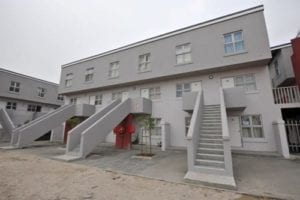“The provision of quality housing and the building of an asset base is a core element in the eradication of poverty. The provision of housing solutions gives the poor a hand up so they can become part of the ‘whole-of-society’.” Minister Bonginkosi Madikizela, Department of Human Settlements: Western Cape
As part of the City of Cape Town’s Human Settlements’five-year plan that aligns the City’s Integrated Development Plan, housing is a priority. In his2013 state of the province [Western Cape] address, Madikizela stated that in order to successfully deliver on a whole-of-society approach, partnership between the province and State is required, as well as the presence of a well capacitated and professional construction sector, the leadership of communities in supporting projects and the willingness of individuals to contribute to what is reasonably expected towards the initial and ongoing success of their housing solutions. The Western Cape’s approach to service delivery is directly in line with government’s National Development Plan. “In Human Settlements, much of our focus is on the poorest of the poor. While 76% of the overall provincial budget is spent on the poor, 93% of our R1.725 billion budget is being spent on those earning less than R3 500 per month,” explains Madikizela. “During April 2012, I handed over a face brick house, in partnership with Corobrik, to wheelchair-bound Angela Mzizi of Strand. She had been staying in a one-room shack constructed by her late husband on a serviced site provided by the department. Through partnership, she can now live with dignity.” As it stands During the 2012/13 financial year, the City of Cape Townhad a very specific plan mapped out in terms of housing delivery. A total of 6044 houses were identified but, unfortunately, only about 4 781 units were delivered on, impacting greatly on provincial targets. The split was as follows:- Winelands District: 2 329 sites were planned and 1 847 delivered. 2 440 houses were planned and 2 324 were delivered. Challenges here included farm worker strikes and the issuing of water licenses.
- Overberg District: 1 591 sites were planned and 1 512 delivered. 557 houses were planned and 541 delivered. Challenges here included contractor appointments and staff capacity.
- Central Karoo District: 570 sites were planned and 589 delivered. 287 houses were planned and 240 delivered.
- Eden District: 2 395 sites were planned and 2 024 delivered. 2 104 houses were planned and 1 813 delivered. Challenges here included contractor appointments.
- West Coast District: 1 162 sites were planned and 1 002 delivered. 656 houses were planned and 1 107 delivered. Here, projects at Graafwater, Doringbaai and Vredendaal were accelerated.
The social housing model
Additionally, the City of Cape Town launched various social housing projects at Scottsdene, Elsie’s River, Bothasig, Dromedaries and Steenberg, with Steenbergbeing the biggest. Launched in early 2009, the Steenberg Social Housing Project has a price tag of around R119 million and aims to deliver on 450 rental units in the Steenberg area. Financing included a R31 million fund from provincial housing subsidies, R57 million from national social housing subsidies and R31 million from loan funding provided by the National Housing Finance Corporation and Dutch International Guarantees for Housing. The main objective of the Steenberg project is to provide quality rental housing in well-located parts of the city at prices affordable to the lower income group. This includes monthly income earners of between R2 500 and R7 500. The idea was to copy this housing model throughout other parts of the Western Cape, hence the birth of other similar social housing projects. Collectively, these projects will provide 1 960 new housing opportunities. On the Steenberg project, the City of Cape Town signed a five-year public-private partnership with SOHCO, Communicare and the Cape Town Community Housing Company. In doing so, it provided leasehold land/buildings and access to subsidies, while the three companies will set up the financial arrangements with the city, and develop and manage the rental stock. Most of the units in Phase 1 were completed in December 2010 and all the units were fitted with solar water geysers and a water retention system on site to help reduce stormwater run-off during the Cape’s rainy winter season. Phase 2 consisted of the development of 150 units and has been delivered on. Phase 3 is currently in motion and will be situated opposite the train station in Steenberg at Military Road, consisting of 600 units – bumping up the initial discussion of 450 total units. “The provision of housing as we currently do it is simply not sustainable and we will need a continued focus on rental, institutional and GAP housing, as well as the leveraging of private funding in the low income and affordable market, in order to provide for all of our people, ”Madikizela continued in her speech. “We have changed our business process to ensure that only projects that have all the approvals in place are included in our business plan and targets for 2014. This should ensure that there will be a limited need for funding reallocation and provide a higher degree of confidence for expected delivery.”







